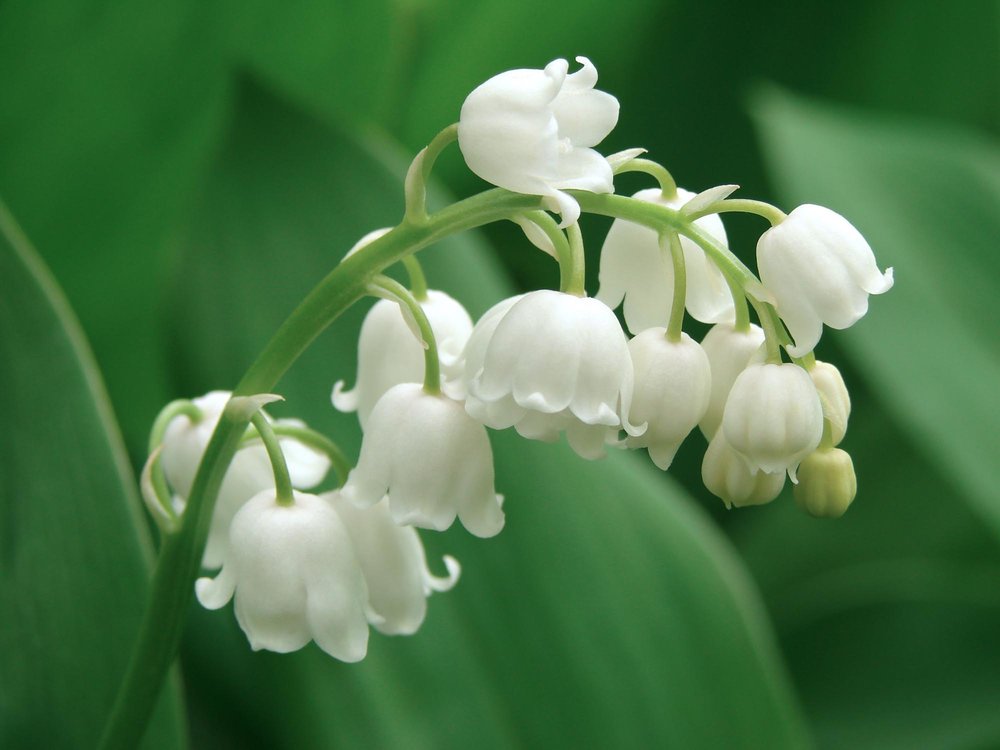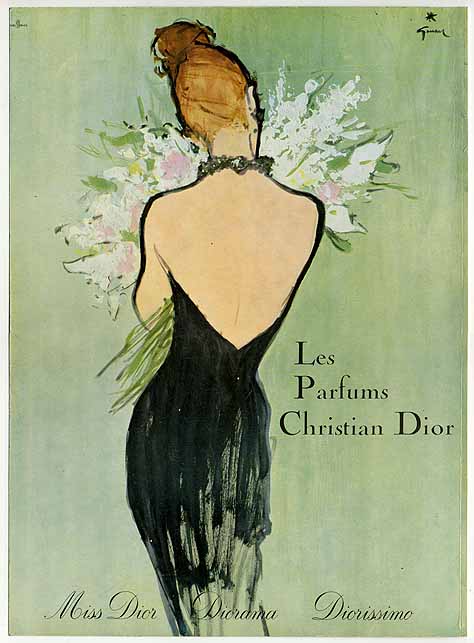
You aren’t supposed to play favourites when you love smells as much as I do. I’ve harped on this very blog before about how there are no bad smells, just smells giving us different information, but I don’t like Lily of the Valley…there I said it. I don’t like the plant, I don’t like the accord. I love perfumes that smell like rumpled sheets and bad decisions. I like flowers with thorns. To me, Lily of the Valley is the scent of a scrubbed clean, blonde, blue-eyed counsellor at an Evangelical gay conversion camp. Just this over the top cloying confection of pretty perfection. Ugh, I hate it, I want to punch it in the face. Well as it turns out dear readers, much like those creepy camp councillors Lily of the Valley has a dark side.

Pretty Poison
My first introduction to the plant Convallaria majalis (also known as Lily of the Valley, May Bells, Mary’s Tears, and Muguet) was one afternoon while weeding the garden with my mother. She turned to me, pointed at the little white blooms and said, “You see this pretty one here? It can kill a man and make it look like a heart attack. It will show up in his blood but only if they are looking for it. ” I wish I were kidding or exaggerating this but in fact, these are the kind of things Mother McBride* thought I should know about when I was 8. I couldn’t tie my shoes properly, but I knew that you can taste belladonna in wine or water but not in coffee. Oh, the joys of Mother-Daughter bonding.

Turns out Mummsie was absolutely right. Lily of the Valley, while it looks sweet and innocent, is incredibly toxic to humans and animals and should be grown with caution. This diminutive plant with its drooping bells and red berries contains at least 38 known cardiac glycosides. Cardiac glycosides are basically plant-based steroids that specifically affect the heart.

They work by modifying an enzyme found in a cardiac cell’s cellular membrane called the sodium-potassium adenosine triphosphatase or the sodium-potassium ATPase pump. The ATPase pump performs an essential function of cellular physiology, it moves potassium and sodium ions in and out of the cardiac cell. This enzyme acts as a pump that helps your cells remove waste and keep them perpetually beating. You need it to live. Glycosides affect the enzyme slowing the pumping action and increasing the force-output of your cardiac cells.

Like any steroid when used in controlled medical dosages, they can save lives. Convallatoxin a glycoside found in the plasma of the Lily of the Valley plant is used to treat congestive heart failure and some types of arrhythmias. However, if ingested in uncontrolled dosages from plants or tinctures, the effects on the heart can be catastrophic and can lead to death.

If you’re thinking, “Nah everything from nature is better then when it is properly controlled in the lab. I’m going to cure my heart condition with herbs” Well, you should know that Lily of the Valley also contains a unique and somewhat strange non-protein amino acid called Azetidine-2-carboxylic acid. This little gem is found only in the Lily of the Valley and is incredibly toxic to humans in small doses. It alters the way your body builds keratin, college, haemoglobin, and how it folds proteins. You essentially start falling apart on a molecular level.
Tricking the Men-folk
It also tricks human sperm. Yes, you read that right. Lily of the Valley tricks sperm cells. See sweet old Lil contains Bourgeonal, an ingredient often used in perfumery and in the creation of Lily of the Valley accords. Bourgeonal like most things associated with this plant is strange. Bourgeonal can mimic Progesterone in in-vitro tests and serves as a chemo-attractant causing human sperm to swim twice as fast and find a human ovum quicker. This isn’t happening because the sperm just adores the smell of white florals. Instead, both sperm and our noses have the olfactive receptor OR1D2 which open calcium ion channels in the sperm, increasing their speed. Both Bourgeonal and Progesterone can activate the OR1D2 receptors in sperm making the little guys swim for all they are worth. Like some hellish spermatozoal catnip.

If this was not reason enough to detest Lily of the Valley, a 2010 study found that men have a higher sensitivity to the scent of Bourgeonal then women possibility because of sexual selection that has favoured males with more OR1D2 receptors both in their noses and their sperm. So dudes are genetically predisposed to just love this stuff…great.
Mary’s Tears
Actually, a genetic predisposition to Lily of the Valley and a connection to reproduction makes a lot of sense when we look at the plant’s use in culture throughout history.
Firstly the name Lily of the Valley comes from the Hebrew phrase shoshannat ha amaqim (lit. rose of the valleys) from the Song of Solomon. Which certainly didn’t refer to Convallaria majalis because it doesn’t grow in the region. Most likely they were talking about Cistus salviifolius aka the rock rose aka the flower that produces gorgeous labdanum. Shoshannat ha maqim turned to kríno tis koiládas in the Greek translation of the Hebrew Bible probably to keep the cadence and rhyme structure of the original poetry, then to lilium convallium in Latin before reaching Lily of the Valley in English.

Despite the Hebrew origins of the name, Lily of the Valley is a plant with long associations in Christianity and Europe. Alternative names for the plant are Mary’s Tears or Eve’s Tears connecting the plant with religious women and the sorrow of loss. The purity of the blooms along with the crimson of the berries both symbolises Mary’s innocence and her tears of blood at her son’s death (a long-held folk belief ) as well as Eve’s lost purity in Eden and her curse of menstruation.

These association may be built on top of earlier pagan associations as we can see remnants of in the Russian fairy tale of the Sea-King’s Daughter. Volkhova, Princess of the Sea, falls in love with the no good Sadko that quickly replaces her for the Princess of the Forests. In the search for her wayward love, Volkhova searches the land for him weeping tears and dripping blood from her worn feet that turn to Lily of the Vally. The symbolising of her faithfulness, love, purity, and sorrow is too similar to the Mary story to not share some mythological DNA.

The flowers connection to Mary, faithful lovers and the Spring (specifically May Day) has led to its association with purity, virginity, chastity, humility, a sweetness of disposition, and kindness. Basically, it symbolises the ideal female persona in the Medieval mindset, and it is no wonder it is the traditional flower of wedding bouquets. It is also the connection to May Day that has made the flower a symbol of Labour Day in France and a bit of a good luck charm. To give someone a bouquet of Lily of the Valley was in a way, to wishing them the pleasures of Spring all year long.

Perfect feminine beauty, chaste sex appeal, the fecundity of Spring and good luck!…no wonder people have coveted this as a personal fragrance for 150 years. If only I didn’t find this so utterly shrill.
Little Liars
But Nuri you say, how can they make perfume out of this stuff. You’ve convinced me its poison, is Annick Goutal trying to kill me!
That would be too simple for this weird little hell beast. See, every Lily of the Valley perfume you have ever smelt is a lie. Lily of the Valley is what is called a mute flower. Mute flowers are flowers that smell in-situ but cannot produce aromatic materials. They either produce no or so little aromatic compounds that it can’t be coalesced into an essential oil (through distillation) or absolute (through solvent extraction). The only way to achieve LotV is by building it as an accord (a collection of materials put together to smell like something else). This is probably a good thing because if we could extract it, it would probably not be safe to use in cosmetic preparations.

But here’s the problem with the accords, the real Lily of the Valley has a low odour profile and is a rather generic soft floral; like a jasmine and a rose had a secret affair that produced an anaemic love child which they abandoned in a pile of green grass. So what Lily of the Valley accord you get is a matter of the perfumer’s interpretation. Some are castrated jasmine, others sickly sweet, few have the balance of nature. As most perfumers that have tried their hand at a Muguet have been male, I can’t help but wonder are they smelling something I can’t? Are their manly Muguet receptors just loving what I perceive as floral assault?

The first in this modern subfamily of the white floral category was Muguet by Guerlain in 1906 followed by Muguet des Bois created by Henri Robert for Coty in 1936. Muguet des Bois was in homage to Francois Coty, the beauty genius and tyrant, that had passed away a year and 1/2 early. Coty was known to cut Lily of the Valley from his garden in May and present good luck bouquets to his workers. Whether this product was a sincere remembrance or a clever act of PR as the company steered itself out from under the shadow of its famous father, the scent was a smash. It would be part of the good girl’s olfactive repertoire of violets and hyacinth until the master Edmond Roudnitska created Diorissimo for Dior in 1956.

Like Muguet des Bois, Diorissimo was about myth making. Dior was insanely superstitious, and many of his talismans have become icons of the brand. Lily of the Valley was one of his totems. He sewed sprigs of it into the hems of his early dresses for luck, and all of his early fragrances were built around it.
Diorissimo was to fragrance what the New Look was to fashion. Forget about those aldehydic gender-bending scents of the 20s and 30s that went with the garcon-look. In the Post War world, the style would be hyper-feminine, almost a return to the Victorian with corsets and crinolines, but now with a new modern edge. So too would the fragrances be a return to traditional femininity but with a new erotic disposition. Virginal Muguet would get a touch of civet in the background along with some powdery iris to make it a sweet girl that is a little bit dirty and a little bit sophisticated.
Every Lily of the Valley fragrance has been trying to catch Roudnitska’s lighting ever since.
Want to Smell like Lily of the Valley?
What’s wrong with you, haven’t I done my job here? Ok, full disclosure there are a few classic Lily of the Valley scents that I like. If you must wear this then at least wear the best.
Diorissimo by Dior
Aqua Alegorica Lilia Bella by Guerlain
Mughetto by Santa Maria Novella
Want to Know More?
Human Male Superiority in Olfactory Sensitivity to the Sperm Attractant Odorant Bourgeonal by Peter Olsson and Matthias Laska
Identification of a Testicular Odorant Receptor Mediating Human Sperm Chemotaxis by Marc Spehr, Günter Gisselmann, et al
Rapid Detection of the Active Cardiac Glycoside Convallatoxin of Lily of the Valley Using LOCI Digoxin Assay by Kerry J. Welsh, Richard Sheng Poe Huang, et al.
Want to Play Some More In The Poisoned Garden?
Then check out these other posts
* PS-Don’t play with poisonous plants kids, you can seriously hurt yourself or others.
PPS- Also to the best of my knowledge my mother has never murder anyone.
PPPS Also…Also, I swear we are not witches. My mother and grandmother just like growing poisonous plants and I like talking about them, like totally ordinary people. Nothing to see here.
Thank you so much for this wonderful post! Even if Lily of the Valley isn’t your favorite flower, you still wrote so many good and interesting things about it! Everything written here is gold, some of them I didn’t even know about.
You see, Lily of the Valley is my favorite flower(I’m sorry). I love it for all the reasons you wrote above. How it’s seen as innocent and pure, but actually not really.lol And also the touch of whimsy. I love how it looks, how small it is, I love it all! It’s really lucky that I also ended up liking how it smells. Sadly I have never smelled a real Lily of the Valley. It doesn’t grow in my country. I only know the smell because of perfumes. Specifically Diorissimo which I am very happy to own and also Penhaligon’s Lily of the valley. The Penhaligon’s one was alright but I remember being overwhelmed by it after a while. I must try my sample again. Lilia Bella and Mughetto are next on my must sniff list! Thank you so much for your recommendations. I would also like to ask if you’ve ever smelled Diorissimo extrait de parfum? Is it true that it smells even more gorgeous?
Forgive me for my super long comment, I just got really excited. I love how you write, I love this post, I’m happy I found your website. Your Mother and Grandmother are so cool, I can’t even!! And I will go read your other posts now!
LikeLike
Lily of the Valley is the favorite flower of someone I love dearly. I’m a quite sensitive person so when you said you hated it I was slightly crushed, but not to worry-I’ve since gotten over my momentary thoughts of suicide. I’ve always thought of Lily of the Valley as a rather boring flower (only up until I met the love of my life, who loves it, of course), but this has convinced me otherwise. Anyhow, your mother sounds like a fabulous woman and I love the way you write, this post was a rather interesting read.
LikeLike